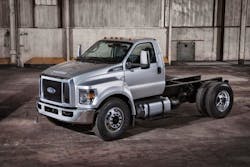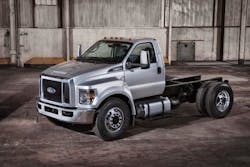Now, Ford’s been selling tractor versions of its F-750 for some time – about 200 units a year or so – but that’s largely been quietly done under the radar. Yet this “official” tractor model rollout harkens back to the heady days when the OEM used to build big highway trucks – 17 years ago, to be exact, before Ford sold its heavy truck manufacturing operations to Freightliner.
[To view more photos of Ford’s new F-650 and F-750 models, click here.]
Ford’s move back into building tractors – albeit Class 7 models – is made more interesting because the OEM is offering a very wide selection of power options with it. First there’s its home-grown 6.7-liter Power Stroke V8 turbocharged diesel engine, mated to a six-speed 6R140 automatic transmission equipped with a power takeoff (PTO) option. Next is a 6.8-liter gasoline V10 engine, available for both F-650 and F-750 models, equipped with a 6R140 six-speed automatic transmission.
That 6.8-liter V10 is also a critical part of Ford’s alternative fuels strategy on the heavy end of the truck market, as it can be factory-prepped to run on either compressed natural gas (CNG) or liquid propane gas (also known as “autogas”).
[Ford’s also put its revamped F-650 and F-750 models through some pretty severe testing as the video below demonstrates.]
Ford’s new F-650 and F-750 – which will be 2016 model year trucks and thus available in the spring of 2015 – are also being introduced at a potentially auspicious time in the commercial truck market, as orders rates are starting to climb.
According to ACT Research, Class 5 through 7 net orders are expected to reach 19,600 units and Class 8 net orders should top 29,200 units – both of them some of the strongest order-rate numbers posted in the last several years.
“February’s Class 8 orders were the fifth best since the second quarter of 2006,” noted Kenny Vieth, ACT’s president and senior analyst. “Despite falling 16% from January, February’s net orders were up 30% compared to a year-ago. Since October, Class 8 orders have been booked at a 320,000 SAAR (seasonally adjusted annualized rate). Going even further afield, since the beginning of the third quarter of 2013, Class 8 net orders have been booked at a 299,000 SAAR.”
He added that, following two months of below trend order placements, Class 5-7 net orders rose to their highest level cycle-to-date at 19,600 units – volume representing an improvement of 14% from January and 22% compared to last February.“Medium-duty orders over the past year can be characterized as ‘slow and steady wins the race.’ Since October, orders have been booked at a 211,000 SAAR, while going back to the beginning of the third quarter 2013, produces a net order SAAR of 210,000 units,” Vieth explained. “Over the 12 months ending February, 206,000 net SAAR orders were booked.”
Similar preliminary numbers tracked by FTR Transportation Intelligence echoes ACT’s analysis, showing February Class 8 truck net orders at 28,876 that, when combined with December and January data, represent the best three-month period since 2006.
FTR said February net orders were a 27% improvement from the same month in 2013 and continue a string of thirteen consecutive months with year-over-year gains, with the last six months of Class 8 order activity annualized to 320,500 units.
“Orders were strong for the third consecutive month and in line with expectations with the market now officially in a growth cycle,” noted Don Ake, FTR’s vice president of commercial vehicles, in a statement. “The confidence in the industry is picking up steam and we expect 2014 to be a healthy year for Class 8 trucks. The current order activity should begin to put pressure on OEM build rates for second quarter to be more in line with the FTR forecast.”
Why does such order rate levels matter? ACT’s Vieth told me by phone that those upticks signal that a far more positive outlook is taking hold among commercial truck buyers – both in the heavy and medium duty sectors but especially among freight haulers.
“You see it in the ATA [American Trucking Associations] tonnage numbers; you see it especially in the recent DAT spot rate index,” he explained to me. “Loads are good and rates are up. As a result, from an anecdotal perspective, truckers I talk to who were guardedly optimistic in October and November were as of several weeks ago VERY happy with the world. It looks as if someone finally flipped the switch.”
Though data does remain mixed at this point as to what the future holds for overall U.S. economic growth – go here and here for some of that – Vieth pointed out that some critical factors are potentially setting the stage for strong commercial truck sales; meaning Ford may be jumping into the mix with its newly redesigned F-650 and F-750, especially its tractor model, at just the right time.
“We identify the ‘active’ Class 8 population as those trucks 15 years and younger,” Vieth explained. “Back in 2003, there were 2 million ‘active’ trucks; by the end of 2013 there were still 2 million ‘active’ trucks. And even though the economy has been growing slowly, it’s still increased 20% over that time. That means now, even if there’s a little bit of growth, there will be no capacity.”
And he stressed that "little bit of growth" is there, with gross domestic product [GDP] numbers now moving closer to 3% versus 2% and below.
Vieth added that while the trucking industry successfully managed freight volumes with the existing population of trucks for several years, alternations to hours of service (HOS) regulations that went into effect back in July 2013 changed everything. “That is what really broke things open,” he said.
Let’s see that “switch” indeed stays “flipped” as we head into spring.


